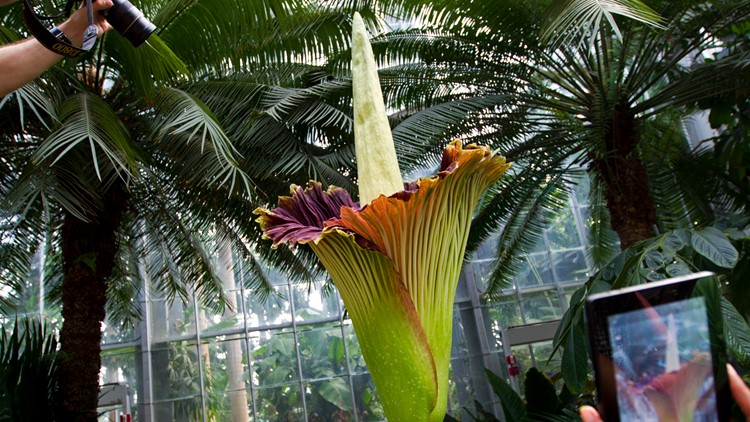LEIDEN, Netherlands — Editor's note: The photo in this story shows a corpse flower, or Amorphophallus titanum, which is similar to the plant mentioned.
A garden in the Netherlands is home to a rare "penis plant." Yes, you read that correctly. And something very uncommon just happened.
The plant, known by its scientific name Amorphophallus decus-silvae, recently bloomed, according to a news release from the Hortus Botanicus Leiden. Only a few botanical gardens have these plants — known for their shape and awful smell — which makes its flowering especially rare, according to the university.
At the university's garden, it's the first time such a plant bloomed since 1997.
The plant was cultivated by Amorphophallus volunteer Rudmer Postma and is about six years old, the release explains. Since mid-September when the flower bud was first spotted, the plant has grown into a 6-foot long stem with a foot tall bud.
The "penis plant" requires a "very warm and humid growing environment" which makes it hard to grow in Europe, CNN reports. It's difficult to exactly guess when the plant will flower, but the Hortus Botanicus Leiden says the smell of the flower actually reveals whether it blooms or not.
There are two phases to the flowering process, the release explains, which are:
First, it blooms female
The spadix, which is the white, phallus-shaped part of the bud, heats up and emits a pungent smell of rotting flesh. Flies and other pollinators love this scent and flock to the plant, the release says.
Then the plant blooms male
It produces pollen, which covers the flies, according to Leiden Hortus Botanicus. After flowering, the flies leave for their next meal.
To have many years between blooms for larger Amorphophallus plants isn't unusual, Deputy Executive Director of the US Botanical Garden Susan Pell said to CNN.
The rare plants' blooms come from their underground structures which are called corms, she explained to the outlet.
"That bloom is just using up all of the energy that's been stored in that corm," Pell said to CNN.
"And so in order to bloom again, that corm has to produce a series of leaves over ... somewhere between probably three and 10 or 12 years in order to get enough energy built back up in the corm to support a bloom, which really occupies that corm for more than a year."
All together, Amorphophallus decus-silvae is considered difficult to get into bloom because of its specific needs, but Postma has managed to get the plant to this point, Hortus Botanicus Leiden said.



